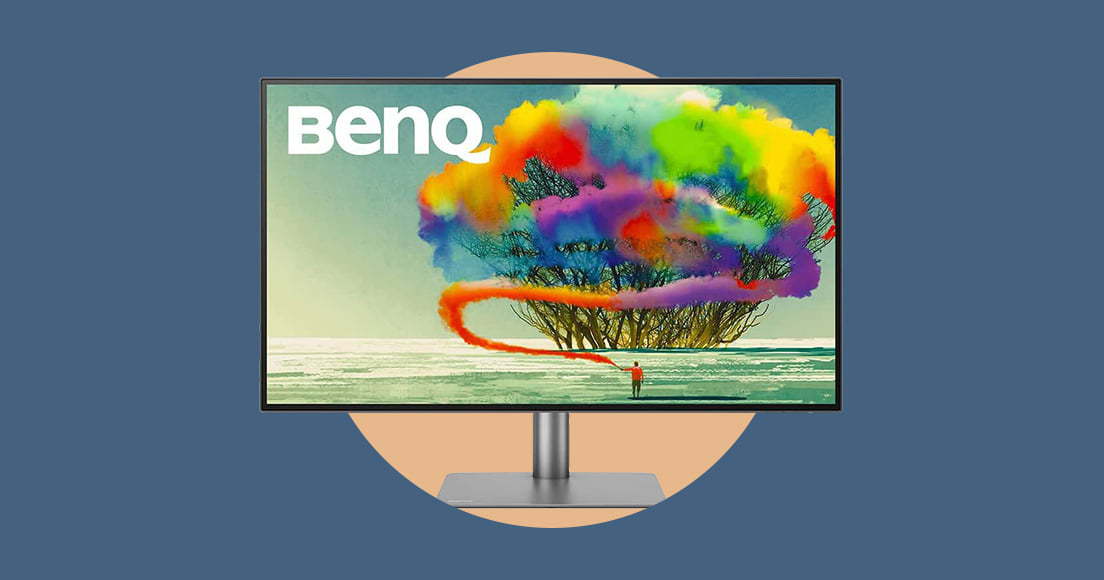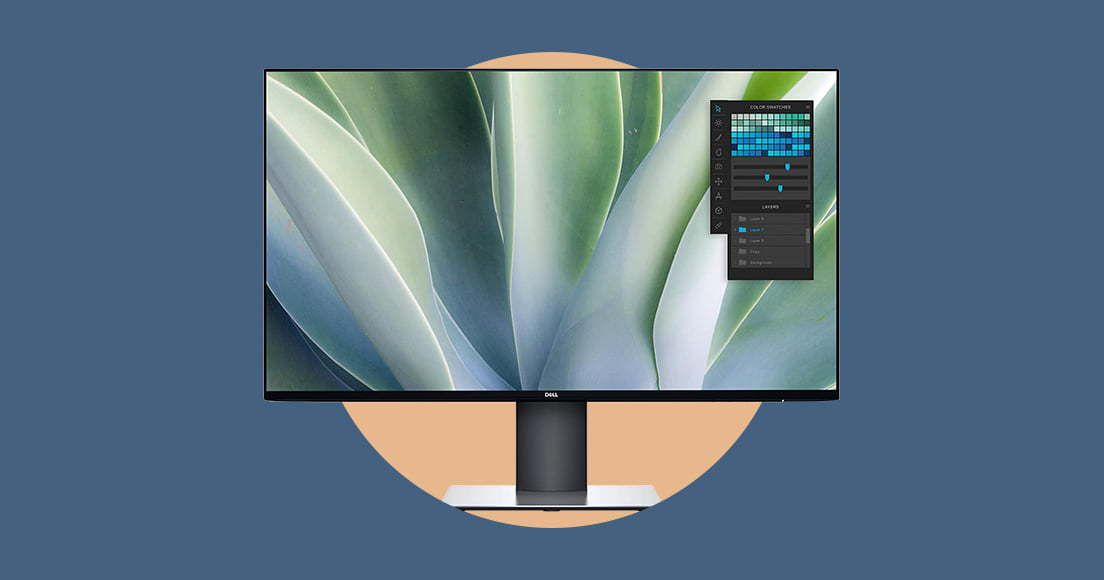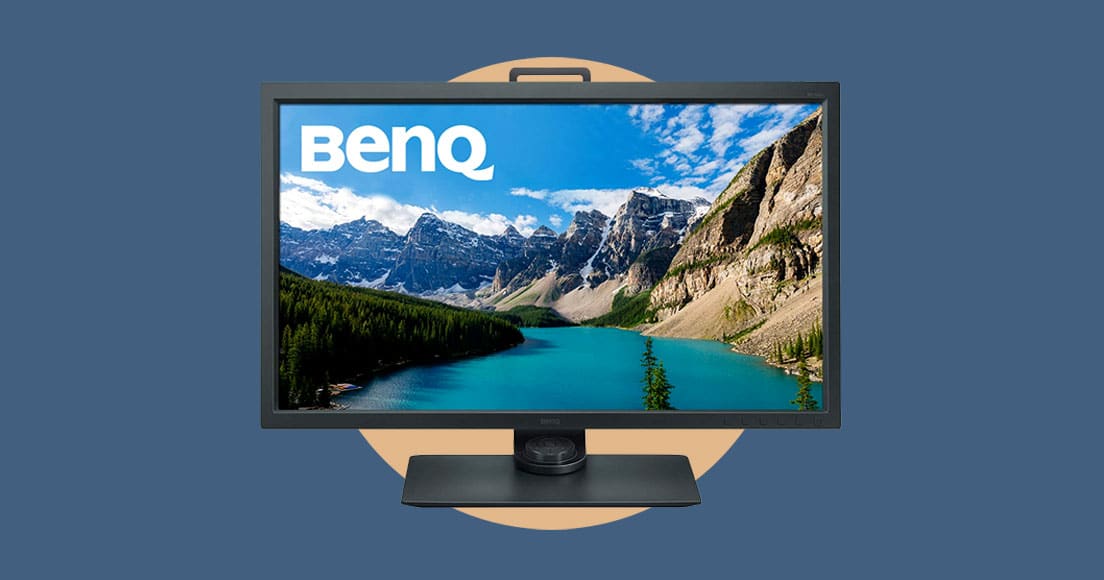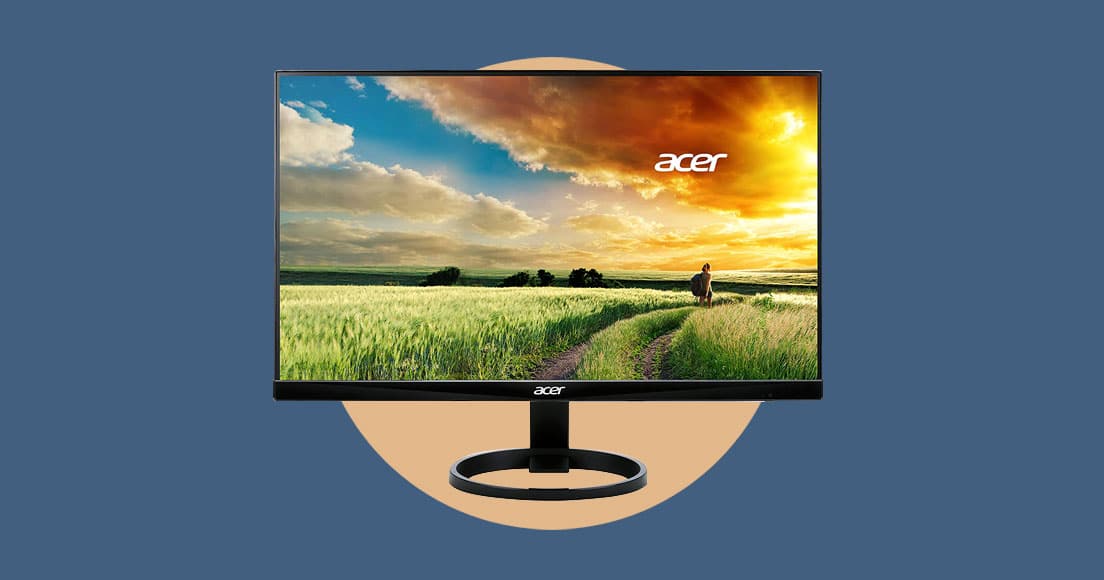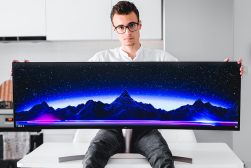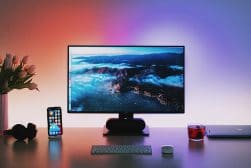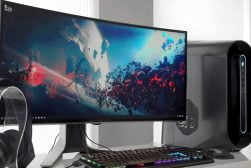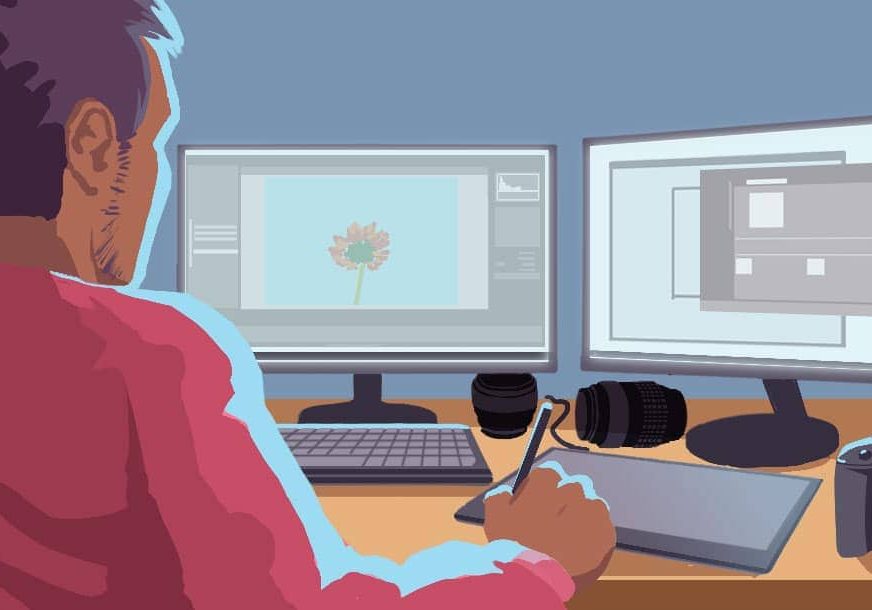
Best Monitor for Photo Editing
Discover the 5 best monitors for photo editing in 2023. Do you need the latest 32 inch 4K wide screen monitor, or will a budget 24 inch screen do the trick?
Accessory Guides | Camera Gear Guides | By Mark Condon | Last Updated: January 11, 2024
This is a round-up review of the best monitor for photo editing in 2024.
If you’re looking for a great external display for laptop or desktop, keep reading to discover which 27″ and 32″ photo editing monitors we recommend.
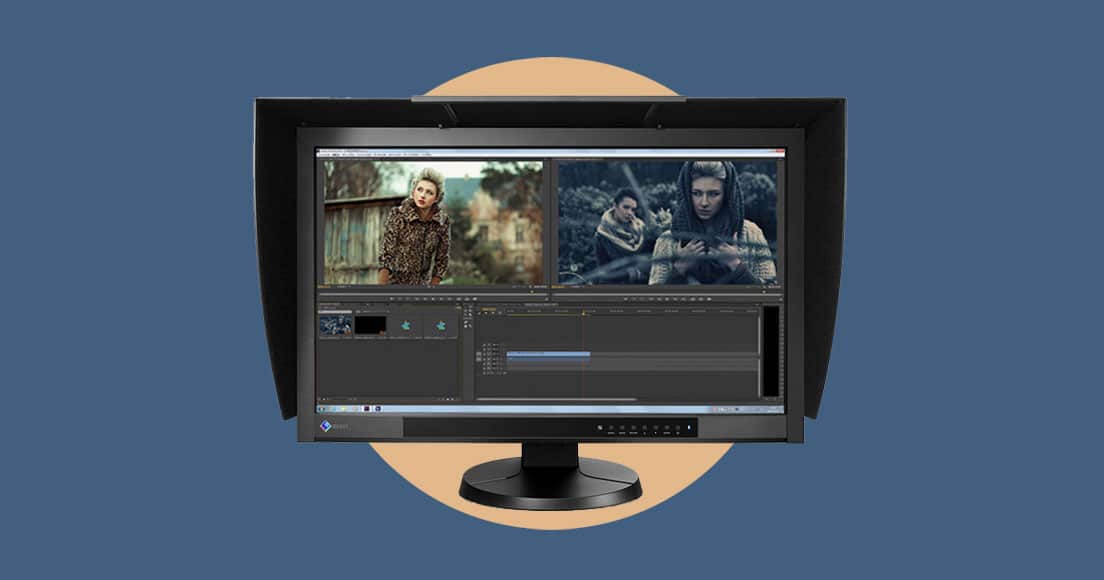
With automatic self-calibration, this monitor offers optimal color accuracy for professional photographers.
No matter what standard you are with your photography and retouching, choosing the right monitor for photo editing is an important step.
Let’s have a closer look at the best monitor to buy based on your needs.
Which Monitor for Photography in 2024?
| Image | Product | Features | |
|---|---|---|---|
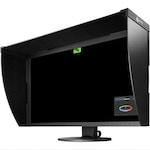 | Eizo ColorEdge CG2730BEST FOR PROS |
| View Price → |
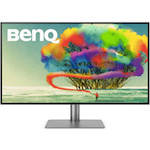 | BenQ PD3220UHIGHLY RECOMMENDED |
| View Price → |
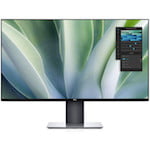 | Dell U2719DXGREAT VALUE |
| View Price → |
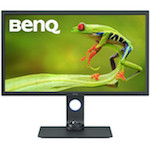 | BenQ SW321CPOPULAR CHOICE |
| View Price → |
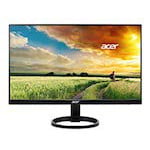 | Acer R240HYBUDGET CHOICE |
| View Price → |
1. Eizo ColorEdge CG2730 – Best for Professional Photo Retouchers
Screen size: 27-inch | Aspect ratio: 16:9 | Resolution: 2560 x 1440 | Brightness: 350 cd/m2 | Response time: 13ms | Viewing angle: 178/178 | Contrast ratio: 1,5000:1 | Color support: Adobe RGB: 99%, DCI-P3: 98% | Weight: 8.9kg
- Oustanding color accuracy
- Edge-to-edge performance
- Balance of price and performance
- Inbuilt calibration tool
- Limited connectivity options
- Priced for professionals
If you’re doing anything where color accuracy is of prime importance, this Eizo monitor is one of the best monitors for photo editing.
The Eizo’s IPS panel has a 6ms grey-to-grey response time, and a backlight system which ensures absolute output uniformity, with brightness dropping by a max of just 3 Delta E… i.e. nothing you’d ever notice!
It offers 99% Adobe RGB Color Space, 99% DCI-P3 and sRGB Mode, combined with a 10-bit panel and 16-bit LUT for the ultimate in color accuracy.
In layman’s terms, all you need to know is that the Eizo ColorEdge CG2730 offers the most incredible color range, with your images representing on-screen exactly what your camera captured.
While other monitors may claim to have near-perfect color accuracy, impressive contrast ratios, HDR, UHD, 4K and whatever other buzzword in their list of statistics, this rarely gives the complete picture, with some measurements being taken from the centre of the screen, ignoring the surrounding edges.
With the ColorEdge CG2730, a monitor recommended by Howard Kim, one of the world’s leading professors in color management, you can expect that no corners have been cut to deliver the best edge-to-edge performance and color accuracy for the most demanding of professional photographers.
Eizo produce several of the best monitors for photo editing, but in our opinion, the CG2730 comes at that sweet spot, balancing price with performance to appeal to most professionals.
In fact, the CG2730 prides itself so highly on delivering the most accurate colors of any monitor on the market, that it includes a built-in calibration device.
Using the included monitor calibration software, you’re able to choose a frequency for the built-in ‘colorimeter’ unit to pop up from the front of the screen like a windscreen washer, and run a quick fully-automated test to see if your colors are still 100% accurate.
It may seem like overkill, and to most photographers reading this it probably is, but for the select few who demand perfect results during delicate portrait edits, and every time they make a print or send a file to a client, the Eizo ColorEdge CG277 really is the gold standard.
All monitors lose their color accuracy over time and need to be calibrated – some even experience stuck pixels. By including an inbuilt calibration tool which can perform tests even when the monitor is not in use, the Eizo ColorEdge CG277 stands head and shoulders over the other best monitors for photo editing.
On the rear of the screen sit a small selection of ports: DVI, Display Port, 2 USB 3.0 and HDMI inputs. Testing with a 2015 Macbook Pro meant attaching the Display Port cable from the monitor to the laptop’s Thunderbolt port, plus an additional USB cable in order to access an external drive attached to the back of the monitor.
In summary, the Eizo ColorEdge CG277 is non-4k, offers rather limited connectivity options, is completely unattractive to look at, and has a rather hefty price tag, but it’s unapologetic and quite deservedly so.
This is a monitor with one sole purpose – to display colors as accurately as possible, and for this, it excels.
2. BenQ PD3220U – Best USB Type C Monitor
Screen size: 32-inch | Aspect ratio: 16:9 | Resolution: 3840 x 2160 | Brightness: 250 cd/m2 | Response time: 5ms | Viewing angle: 178/178 | Contrast ratio: 1,000:1 | Color support: 99% AdobeRGB, 95% P3, 100% sRGB | Weight: 10.4kg
- Stylish
- Intelligent connectivity options
- Stunning 4K resolution
- Blue light filters
- Priced on the higher side
When it comes to finding the best monitor for photo editing, you’re bound to come across BenQ monitors. The brand has become synonymous with delivering excellent color accuracy desired by designers, video editors and of course photographers.
The BenQ PD3220U is one of the most stylish monitors on the market. For those that crave modern aesthetics in their tech, this ultra-wide monitor will blend in with even the most minimalist of desk set-ups.
Thanks to its elegant framing, thin bezel edge and minimalist stand the PD3220U looks perfect set up next to all your high-tech Apple products, and works flawlessly connected to a Macbook Pro.
With the unique single-cable solution adopting Thunderbolt 3 tech, the system transfers audio, video, data and 85W of power while also charging your Macbook Pro. What’s more, you can use a daisy-chain approach to link up to additional monitors via USB-C connection.
The PD3222 also features ports for HDMI, mini DisplayPort, USB type C, USB-3, audio and SD cards. It’s a handy USB C Hub monitor for those wishing to connect other Mac peripherals to it.
The BenQ PD3220U delivers stunning 4K resolution and is tailored to operate seamlessly with your Mac through the use of its M-Book mode. This makes it one of if not the best 4k monitor for photo editing. Using the included Hotkey Puck G2 or the associated Display Pilot software you can optimise the synchronised color matching with your Mac, to accurately represent your favourite Lightroom preset or Premiere Look Up Table (LUT).
The G2 Puck is ideal for quick and accurate control of screen brightness as well as setting custom keys for everyday functions. As for the Display Pilot software, it’s compatible with both Mac and Windows and provides the necessary tools to improve design work and control monitor settings.
The BenQ PD3220U is a whopping 32-inch monitor providing visual creatives with an expansive canvas for their work. The monitor delivers 4K, 3840 x 2160 resolution with wide viewing angles. You can also position it horizontally or vertically.
The monitor punches out a stunning 300 nits of brightness to make your work pop. In addition, the contrast ratio is perfectly tuned for visual creatives.
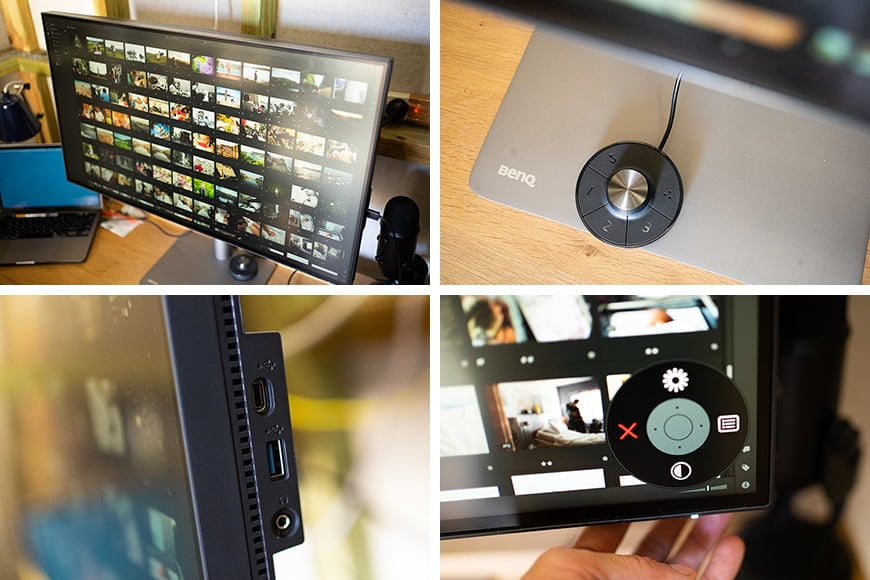
The best monitor for photo editing definitely needs to offer the best color accuracy. The BenQ delivers on this need thanks to an upgraded color gamut, with patented AQColor technology supporting 95% DCI-P3 and Display P3, 100% of sRGB and Rec. 709 color spaces with 10-bit color, both Calman Verified and Pantone Validated.
The PD3220U also comes pre-calibrated directly from the factory and includes its own unique calibration report card for reference.
For the most discerning visual creatives, the BenQ PD3220U features bespoke display modes for optimised and professional-grade results. This range of modes is tailored to suit various editing genres including CAD/CAM, Darkroom and Animation.
For the videographers, it’s compatible with HDR10 ensuring that you can view HDR video accurately.
One of the biggest challenges in working with the digital medium is the strain on your eyes. Fortunately, BenQ has worked to address this with their eye-care processes. The monitor filters damaging blue light with their Low Blue Light Tech process.
Further to this, the monitor works to minimise eye fatigue from flickering with their flicker-free technology, meaning you can spend many more hours editing your photos in front of your computer.
The BenQ PD3220U deserves its spot on this guide to the best monitor for editing photos and managing graphic mediums. With its 4K screen resolution, massive screen size and capabilities in optimising color reproduction and accuracy, you may be surprised how sharp and vibrant your work actually looks!
3. Dell Ultrasharp U2719DX – Best Mid Range Monitor for Photo Editing
Screen size: 27-inch | Aspect ratio: 16:9 | Resolution: QHD 2560 x 1440 at 60 Hz | Brightness: 350 cd/m² | Response time: 8 ms (normal); 5 ms (fast) | Viewing angle: 178/178 | Contrast ratio: 1,000:1 | Color support: 99.9% sRGB, 99% Rec 709, 85% DCI-P3 | Weight: 3.9kg
- Excellent clarity Dell flat panel monitor
- Immersive ‘InfinityEdge’ thin bezel
- Highly adjustable with pivot and tilt
- Great all-rounder
- Some users report border shadows
When it comes to finding the best monitor for photo editing, the Dell Ultrasharp U2719DX stands out as a worthy contender in the 1440p 27 inch monitor class.
The Dell Ultrasharp is another well-designed flat screen computer monitor that features a fine bezel edge that all but disappears under the brightness of the screen. The stand has a solid yet minimal appeal and allows for screen positioning to your liking.
You can effortlessly pivot, tilt, swivel and adjust the height of the monitor to ensure optimal ergonomics and viewing capacity, and thanks to the extremely thin bezel known as InfinityEdge, you can work with multiple monitors side-by-side and have an almost uninterrupted view.
The U2719DX boasts a range of ports and terminals to support even the most complex editing workflow. It houses ports for HDMI, DP Connection (In and Out), Audio Line-Out and USB downstream and upstream ports.
The 27-inch monitor cranks out stunning image quality, thanks to its QHD with a high resolution of 2560×1440 – approximately 1.8 times greater detail than a Full HD display.
It’s guaranteed with 99% sRGB color accuracy from the factory, with extreme precision for photo editing. The W-LED unit offers a standard color gamut, which is roughly equal to the sRGB colour space for 99% Rec709 and 85% DCI-P3 color space coverage, ensuring video production is optimised.
The U2719DX features In-Plane Switching (IPS) providing color consistency and vibrancy through the wide viewing angles. This is especially important for photo editing workflows that require multiple monitors across a desktop, with the viewing angles coming in useful when clients proof over your shoulder during studio work.
The Dell Display Manager software application supports the Dell Ultrasharp monitor. It’s an easy to master interface allows for tiling multiple applications across multiple monitors to maximise your workflow.
A handy feature for those connecting laptops to the Ultrasharp display is the Auto-restore function, meaning that when you disconnect and reconnect to the monitor, all your applications are in the same location.
While we have mostly focused on the photo editing capabilities of this monitor, the Ultrasharp is, in fact, just a great all-rounder. It’s a high-end monitor marketed for a range of uses and purposes including graphic applications.
While on the hunt for the best monitors for photo editing, take a closer look at the Dell Ultrasharp U2719DX with its impressive image quality.
4. BenQ SW321C PhotoVue – Best Large Monitor for Photo Editing
Screen size: 32-inch | Aspect ratio: 16:9 | Resolution: 3,840 x 2,160 | Brightness: 250 cd/m2 | Response time: 5ms | Viewing angle: 178/178 | Contrast ratio: 1,000:1 | Color support: 99% Adobe RGB Color Space, 95% P3, 100% sRGB | Weight: 25.6kg
- Great color accuracy
- Fast refresh rate
- Solid build
- Excellent image quality
- Dated aesthetics
- Big and heavy
Don’t be deceived by the out-dated design of the SW321C – this is a monitor with impressive Adobe RGB accuracy, fast refresh rate, and excellent hardware features, all nestled behind a gorgeous 32 inch screen.
It comes with a detachable shading hood to reduce screen glare from ambient light sources, helping enormously when soft-proofing images for accurate print output.
In terms of connectivity, the BenQ SW321C features the same USB-C single cable system for high-speed data flow, whilst also providing a 60W power supply to your laptop. Plus, you can easily connect multiple monitors and ensure consistency in color representation across the board.
The included HotKey Puck G2 provides fast and simple access to a range of shortcuts for color modes and settings – particularly useful is the ability to adjust your monitor’s brightness – something that sounds simple, but can prove rather tricky when using a laptop with an external display.
When it comes to color accuracy, the BenQ models offer excellent bang for the buck. The monitors arrive with factory-calibrated color accuracy with a unique report card certifying the process.
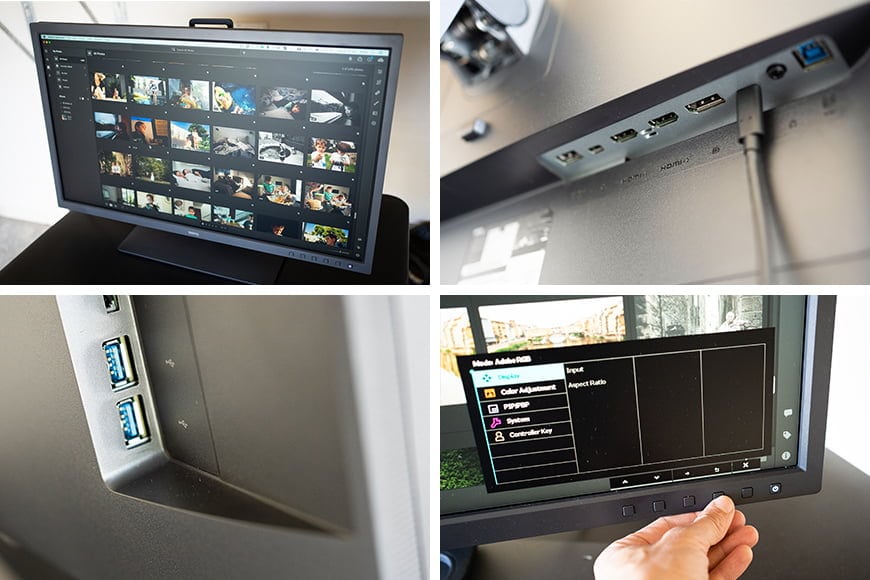
The SW321C has a neat feature where you can see a preview of your image in a range of ways on the same screen. There are three sets of black and white film effects as well as the BenQ GamutDuo that allows you to view two alternate color gamuts – one next to the other.
Most importantly, the BenQ SW321C features AQColor for stellar color accuracy with 99% Adobe RGB, 100% sRGB/Rec. 709, and 95% P3 color spaces. The monitor also features a 16-bit lookup table (LUT) for optimal color rendering accuracy.
The screen delivers corner-to-corner color precision and brightness making it still one of the best monitors for photo processing and visual arts. Plus, for those that intend to print their work and still maintain true-to-life color, it comes with Paper Color Sync software and ART (Advanced ReflectionlessTechnology) panels.
For videographers, the BenQ SW321C effortlessly support both HDR10 and HLG formats. It accommodates 24P/25P frame rate for preview at native cadence without any hint of distortion. It also supports the professional-grade video calibration software Calman and LightSpace.
While the BenQ SW321C might be a little on the old side from an aesthetics point of view, it still packs a punch and confidently makes the cut for best monitors for photo and video workflows.
Acer R240HY
- Affordable 24 inch Mac and PC monitor
- Uncomplicated
- Elegant thin bezel
- Great for entry-level users or as a secondary display
- No calibration tool
- Limited connectivity
This Acer isn’t a specialist monitor for photo editing – it’s just a decent, all-round monitor at a very attractive price point.
It’s labelled as a widescreen monitor for photo editing, although 24″ may not be wide enough for professional photographers.
We included the Acer R240HY in this best monitor for photo editing round-up since aside from the Eizo (which is in a class of its own), this monitor is the only other non-4k monitor recommended here.
4k can be an advantage in some instances, but may be a hindrance in others, particularly when a lot of text is involved – at full 4k resolution on a 27″ monitor, text and UI elements of your screen become so small as to be pretty much illegible.
It’s great to have the additional detail of 4k when viewing photos or editing video, but you’ll need to compromise a little or choose a happy midpoint DPI resolution for mixed usage.
With the 1080P resolution of the Acer R240HY, this is no longer an issue and doesn’t give you the feeling that you’ve paid for something you’re not using, like when up-scaling your desktop by 120-150% DPI with a 27″4K monitor.
If you’re doing any kind of editing on the Acer R240HY, I strongly recommend you invest in a calibration device such as the simple-to-use X-Rite ColorMunki.
The R240HY features a 72% NTSC color gamut – while colors look vivid on the Acer straight out of the box, without actually calibrating it, you’d be editing your images without any true reference point.
Connectivity-wise, the Acer R240HY is rather limited, with 1 HDMI, 1 DVI and 1 VGA input, meaning some dongling will be in order if you have a Macbook or any computer that relies on a Display Port connection.
On the plus side, the thin bezel means that the Acer R240HY is a great option for a multi-monitor set up, with the edges melting into each other unobtrusively.
Due to its attractive, uncomplicated design, it looks great as a secondary display, next to your best photo editing monitor.
All in all, it’s rare to find a good quality, 27″ IPS technology monitor with a nice external design for around $200, but Acer has done it with the R260Y.
At this price you may want to buy two and run them side by side in a dual monitor setup.
What are the Best Monitor Specs for Photo Editing?
If you’re looking for a monitor for photo editing, there are several specs and features that you should consider:
- Resolution: A higher resolution provides more screen real estate and ensures that fine details are displayed. A resolution of at least 1920 x 1080 is recommended, but a 4K monitor with a resolution of 3840 x 2160 or higher is ideal for professional-level photo editing.
- Colour gamut: A monitor’s colour gamut is the range of colours it can display. For photo editing, it is important to have a monitor with a wide colour gamut that can display the full sRGB colour space or even better, Adobe RGB or DCI-P3 colour space. This allows you to see more colours and shades, which is essential for accurate colour reproduction.
- Contrast ratio: This refers to the difference between the darkest and lightest tones that a monitor can display. A high contrast ratio ensures that shadows and highlights are accurately displayed, providing more detail in the image. Look for a monitor with a contrast ratio of at least 1000:1 or higher.
- Viewing angles: When editing photos, you need to be able to view the image accurately from different angles – this is particularly the case for clients or team members who may be selecting photos over your shoulder. You should choose a monitor with an IPS or PLS panel, as these provide the widest viewing angles with consistent color accuracy.
- Brightness: A high brightness level is essential for photo editing, as it helps you to see fine details and accurately judge colors, even in bright light. Look for a monitor with a brightness level of at least 250 cd/m² or higher, particularly if you need to use it in a brightly lit studio or outdoors.
- Calibration: For professional photo editing, you should use a monitor that can be calibrated to ensure accurate color reproduction. Some monitors come with built-in calibration tools, while others may require an external calibration device like a Spyder.
FAQs
What’s the best LG monitor for photo editing?
The LG 27UK850-W, LG 27GN950-B and LG 32UL950-W are 3 popular options with wide colour gamuts and wide viewing angles.
Do I need a 4K monitor for photo editing?
While 4K allows you to see more detail at once, it’s not absolutely essential for amateur and hobbyist photo editing tasks. However, it’s recommended to use 4K for professional photographers and filmmakers. See our guide which compares 4k with 1080p.
Is IPS better than an LED monitor for photo editing?
IPS offers the best colour accuracy and better viewing angles, so in general, it’s better for photo editing than a standard LED monitor.
Is OLED better than LCD for photo editing?
OLED offers better contrast ratios and colours than LCD, making it better for photo and video editing. However, OLED monitors generally have a shorter lifespan than LCD monitors, so may need to be replaced more frequently.
Is a 32-inch monitor too big for photo editing?
For most people, 27 inches is the sweet spot for monitor size for photo editing. You can get an affordable 27 inch monitor, whereas 32 inch monitors are more expensive. However, for the best monitor for video editing, the bigger the monitor, the better, since you can put the extra screen real estate to good use.
Where to buy monitors?
You can buy monitors from the brand’s brick-and-mortar stores or online shopping platforms like Amazon.
How to buy a computer monitor?
First, know the purpose of the monitor. Will it be for gaming, photography, or office works? Next, look for candidates and see if their specs fit your needs. Lastly, check if the monitor suits your budget.
Are curved monitors good for photo editing?
No. Curved monitors may not be the ideal choice for photo editing as they might cause image distortion.
How much does a Dell monitor cost?
A Dell monitor costs between $75 to $400 apiece.
What is the best 27-inch monitor to buy?
There are a few to choose from, such as the Dell U2723QE, Gigabyte M27Q, and LG 27GP950-B.
What type of monitor is best for Photoshop?
A monitor with good colour accuracy and a high resolution will suit frequent Photoshop users the best. Depending on the number of adjacent Photoshop windows you need open, screen size will also be a consideration too.

With automatic self-calibration, this monitor offers optimal color accuracy for professional photographers.





